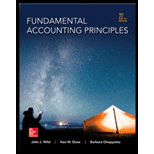
Fundamental Accounting Principles -Hardcover
22nd Edition
ISBN: 9780077862275
Author: John J Wild, Ken Shaw Accounting Professor, Barbara Chiappetta Fundamental Accounting Principles
Publisher: McGraw-Hill Education
expand_more
expand_more
format_list_bulleted
Concept explainers
Textbook Question
Chapter 1, Problem 14QS
Classify each of the following items as assets (A), liabilities (L), or equity (EQ).
1. Land_____
2. Owner, Capital_____
3. Equipment_____
4. Accounts payable_____
5. Accounts receivable_____
Expert Solution & Answer
Want to see the full answer?
Check out a sample textbook solution
Students have asked these similar questions
Can you help me of solve this question? ?
answer plz
What was the variable overhead rate variance for the month?
Chapter 1 Solutions
Fundamental Accounting Principles -Hardcover
Ch. 1 - Prob. 1DQCh. 1 - Technology is increasingly used to process...Ch. 1 - Prob. 3DQCh. 1 - What are at least three questions business owners...Ch. 1 - Prob. 5DQCh. 1 - Describe the internal role of accounting for...Ch. 1 - Prob. 7DQCh. 1 - Prob. 8DQCh. 1 - Prob. 9DQCh. 1 - What are some accounting-related professions?
Ch. 1 - Prob. 11DQCh. 1 - Prob. 12DQCh. 1 - Prob. 13DQCh. 1 - Prob. 14DQCh. 1 - Prob. 15DQCh. 1 - Prob. 16DQCh. 1 - Prob. 17DQCh. 1 - Prob. 18DQCh. 1 - Prob. 19DQCh. 1 - Prob. 20DQCh. 1 - Prob. 21DQCh. 1 - Prob. 22DQCh. 1 - Prob. 23DQCh. 1 - Prob. 24DQCh. 1 - Prob. 25DQCh. 1 - Prob. 26DQCh. 1 - Prob. 27DQCh. 1 - Define and explain return on assets.Ch. 1 - Prob. 29DQCh. 1 - Prob. 30DQCh. 1 - Prob. 31DQCh. 1 - Prob. 32DQCh. 1 - Prob. 33DQCh. 1 - Prob. 34DQCh. 1 - Prob. 35DQCh. 1 - Prob. 1QSCh. 1 - Prob. 2QSCh. 1 - Prob. 3QSCh. 1 - Prob. 4QSCh. 1 - Prob. 5QSCh. 1 - Prob. 6QSCh. 1 - Prob. 7QSCh. 1 - Prob. 8QSCh. 1 - Prob. 9QSCh. 1 - Prob. 10QSCh. 1 - Prob. 11QSCh. 1 - Prob. 12QSCh. 1 - Prob. 13QSCh. 1 - Classify each of the following items as assets...Ch. 1 - Prob. 15QSCh. 1 - Prob. 16QSCh. 1 - Prob. 17QSCh. 1 - Prob. 1ECh. 1 - Prob. 2ECh. 1 - Prob. 3ECh. 1 - Prob. 4ECh. 1 - Prob. 5ECh. 1 - Prob. 6ECh. 1 - Prob. 7ECh. 1 - Prob. 8ECh. 1 - Prob. 9ECh. 1 - Prob. 10ECh. 1 - Prob. 11ECh. 1 - (
Provide an example of a transaction that...Ch. 1 - Prob. 13ECh. 1 - Prob. 14ECh. 1 - Prob. 15ECh. 1 - Exercise 1–16
Preparing a statement of owner’s...Ch. 1 - Prob. 17ECh. 1 - Prob. 18ECh. 1 - Prob. 19ECh. 1 - Prob. 20ECh. 1 - Prob. 21ECh. 1 - Prob. 1APSACh. 1 - Prob. 2APSACh. 1 - Prob. 3APSACh. 1 - Prob. 4APSACh. 1 - Prob. 5APSACh. 1 - Prob. 6APSACh. 1 - Prob. 7APSACh. 1 - Prob. 8APSACh. 1 - Prob. 9APSACh. 1 - Prob. 10APSACh. 1 - Prob. 11APSACh. 1 - Prob. 12APSACh. 1 - Prob. 13APSACh. 1 - Prob. 14APSACh. 1 - Prob. 1BPSBCh. 1 - Prob. 2BPSBCh. 1 - Prob. 3BPSBCh. 1 - Prob. 4BPSBCh. 1 - Prob. 5BPSBCh. 1 - Prob. 6BPSBCh. 1 - Prob. 7BPSBCh. 1 - Prob. 8BPSBCh. 1 - Prob. 9BPSBCh. 1 - Prob. 10BPSBCh. 1 - Prob. 11BPSBCh. 1 - Prob. 12BPSBCh. 1 - Prob. 13BPSBCh. 1 - Prob. 14BPSBCh. 1 - Prob. 1SPCh. 1 - Prob. 1BTNCh. 1 - Prob. 2BTNCh. 1 - Prob. 3BTNCh. 1 - Prob. 4BTNCh. 1 - Prob. 5BTNCh. 1 - Prob. 6BTNCh. 1 - Prob. 7BTNCh. 1 - Prob. 8BTNCh. 1 - Prob. 9BTN
Knowledge Booster
Learn more about
Need a deep-dive on the concept behind this application? Look no further. Learn more about this topic, accounting and related others by exploring similar questions and additional content below.Similar questions
- need help this problemarrow_forwardWhat is the percent change in sales for year 2 compared to the base year of this financial accounting question?arrow_forwardPhoenix Industries has twelve million shares outstanding, generates free cash flows of $75 million each year, and has a cost of capital of 12%. It also has $50 million of cash on hand. Phoenix wants to decide whether to repurchase stock or invest the cash in a project that generates free cash flows of $3 million each year. Should Phoenix invest or repurchase the shares? A) Repurchase B) Invest C) Indifferent between options D) Cannot say for sure provide answerarrow_forward
- At the beginning of the year, Anderson Corporation's assets are $275,000 and its equity is $198,000. During the year, assets increase by $95,000 and liabilities increase by $58,000. What is the equity at the end of the year? Helparrow_forwardfinancial accounting is answerarrow_forwardSolve this Accounting problemarrow_forward
arrow_back_ios
SEE MORE QUESTIONS
arrow_forward_ios
Recommended textbooks for you
 Cornerstones of Financial AccountingAccountingISBN:9781337690881Author:Jay Rich, Jeff JonesPublisher:Cengage Learning
Cornerstones of Financial AccountingAccountingISBN:9781337690881Author:Jay Rich, Jeff JonesPublisher:Cengage Learning College Accounting, Chapters 1-27AccountingISBN:9781337794756Author:HEINTZ, James A.Publisher:Cengage Learning,
College Accounting, Chapters 1-27AccountingISBN:9781337794756Author:HEINTZ, James A.Publisher:Cengage Learning, Auditing: A Risk Based-Approach to Conducting a Q...AccountingISBN:9781305080577Author:Karla M Johnstone, Audrey A. Gramling, Larry E. RittenbergPublisher:South-Western College Pub
Auditing: A Risk Based-Approach to Conducting a Q...AccountingISBN:9781305080577Author:Karla M Johnstone, Audrey A. Gramling, Larry E. RittenbergPublisher:South-Western College Pub- Principles of Accounting Volume 1AccountingISBN:9781947172685Author:OpenStaxPublisher:OpenStax College

Cornerstones of Financial Accounting
Accounting
ISBN:9781337690881
Author:Jay Rich, Jeff Jones
Publisher:Cengage Learning

College Accounting, Chapters 1-27
Accounting
ISBN:9781337794756
Author:HEINTZ, James A.
Publisher:Cengage Learning,

Auditing: A Risk Based-Approach to Conducting a Q...
Accounting
ISBN:9781305080577
Author:Karla M Johnstone, Audrey A. Gramling, Larry E. Rittenberg
Publisher:South-Western College Pub

Principles of Accounting Volume 1
Accounting
ISBN:9781947172685
Author:OpenStax
Publisher:OpenStax College
The ACCOUNTING EQUATION For BEGINNERS; Author: Accounting Stuff;https://www.youtube.com/watch?v=56xscQ4viWE;License: Standard Youtube License